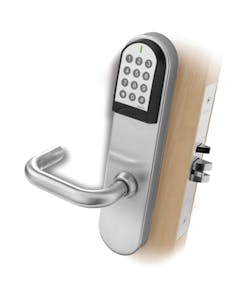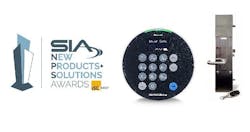As part of our continuing coverage of the future of access control, Ledger technical editor Jerry Levine asked both a representative from an electronic access control company and an experienced locksmith to share their perspectives on the future of electronic access control (EAC). Following are the Ledger’s questions and answers from Bruce Lindstrom, Northeast regional sales manager for Salto Systems, and Glenn Younger, co-owner of Grah Safe and Lock.
Q & A: Bruce Lindstrom
What do you see as the future of electronic access control? Please discuss new products, credentials and software.
Salto will continue to develop new locking devices to help reduce the number of mechanical keys required in a facility so that everyone uses their credential instead of metal keys. Salto has released a number of new products, which utilize a low- cost electronic cylinder for use in mortise and rim cylinders and electronic padlocks. Recent releases include a wireless cylinder, a rack server handle and an electronic cam lock. Electronic lockers have been released for securing many smaller cabinets and lockers.
For new credentials, the obvious pick here is the expansion of Near Field Communications (NFC) technology into the U.S. market. This Smartphone technology has been utilized in Europe and the Pacific Rim where Salto has been shipping NFC-capable locks for over half a dozen years. Here in the United States, it means your Smartphones with enabled NFC will replace credentials and credit cards. This is a technology shift. After all, who leaves home without their cell phone? NFC will make your phone indispensable.
More and more programs are moving to the cloud. We will see more products that are cloud-based for low to medium security applications.
How is your company responding to Electronic Access Control challenges? What is your company doing to restrict unauthorized access? Do you see security increasing by implementing biometrics and/or a second credential?
For a manufacturer, the challenge is always to remain ahead, developing new hardware and software solutions that separate Salto Systems from others. While the United States is slow in accepting new card technologies, the NFC technology may actually help the United States to leapfrog into the forefront. Many companies are heavily invested in magnetic stripe and low frequency 125 kHz proximity technology that are easily duplicated.
Salto Systems has several features that help to eliminate unauthorized access. Card + PIN is one higher level approach to defeating stolen cards and unauthorized access. The Salto Virtual Network technology (SVN) core feature is the re-validation of credentials for a short period of time. A unique feature of SVN, it updates credentials and eliminates lost cards. The use of wireless readers also adds to the immediacy of deleting lost or stolen cards.
Does Salto Systems provide training for locksmiths who are interested in expanding their business?
Salto Systems has a dealer program where selected locksmith companies can become certified as Salto Inspired Business Partners (called IBPs). Salto System products are not available through locksmith distribution.
Where do you see electronic access control in five, 10 and 20 years?
It is so hard to predict things in the short term, forget the long term. Certainly, the NFC phones will make life a bit easier. We are still strongly attached to metal keys and cards but the cost of electronics is dropping. The convergence of physical security/access control at the residential level will grow as people add CCTV and home automation. What can we expect in 20 years? We will have to ask Bill Gates’ kids!
The comments made are from my personal point of view and are not necessarily those of the Salto Systems Management.
Founded in 2000, Salto Systems is a leading manufacturer of RFID locks. Salto was recently ranked #8 worldwide for access control. Salto, a Spanish word that translates as “jump” or leap, as in the Salto leap of technology with the Salto Virtual Network (SVN). The unique read/write SVN technology uses Smartcards in wireless, hard-wired and wire-free configurations. SVN makes access control affordable for many doors that have been designated as mechanical key access only. For more information, visit www.saltosystems.com.
Q & A: Glenn Younger
What is the future of electronic access control from the point of view of a locksmith who sells electronic access control products to end users? Please discuss your thoughts on new products, credentials and software.
We define access control as the ability to do three things:
- Lock or unlock a door
- Provide an audit trail and/or
- Allow for scheduling
Using that definition, the primary limiting factor on the number of doors that have access control has been cost. I have heard estimates that between 2-5 percent of all commercial doors have some form of access control now with average costs of between $2,000 and $5,000 a door.
Access control will continue to grow and cost will continue to be a limiting factor. So, I believe that the future of access control will come from growth in three main areas.
- Lower cost per door
- Different types of credentials and readers
- Wireless or wire-free door controls
For your company is electronic access control growing?
Yes; a real growth area for us.
How is your company responding to the challenge?
We are growing our access control business in a few areas.
- Customers who have existing mechanical key systems upgrading to higher levels of access control.
- New customers who are looking to add access control and they do not have a supplier already.
- Installing door hardware for others who do access control acting as a sub-contractor. Generally we do the installation onto doors, gates and frames for alarm companies, integrated and building management companies who do not have the door hardware experience to handle these installations
What is your company doing to provide your customers with the ability to restrict unauthorized access?
As a part of any access control, we also offer a few things such as:
- A variety of credentials to control the door or gate. Cards, Fobs, Biometrics, and more recently smart phones and smart credentials are some of the options we will suggest. Smart Phone and Smart credentials are offering some unique and flexible options.
- Making sure the doors close on access control doors by adding Door Closers. It always amazes me to see doors with thousands of dollars of electrified hardware standing open. Although this is generally not a problem on exterior doors, we see it all the time on interior doors such as server rooms.
- Adding restricted or key control cylinders to the mechanical lock that is the mechanical bypass for any electronic access control. We believe that it makes no sense to spend $2,000 to $5,000 per door and then leave a cylinder and key that can be duplicated at any swap meet or big box retailer with no verification.
- When restriction is a top priority, the audit trail is a critical feature. We often suggest is adding video or CCTV. That gives an additional level of confirmation and accountability.
- I have to mention smart phones again. Bluetooth and NFC work in concert with the one credential that we work very hard to not lose - our mobile phones.
Do you see the security level increasing by implementing biometrics or a second credential?
When there is a real need to restrict access, a second level of authentication is important. This is especially important when using a “dumb” credential such as a basic Prox card or fob. Most credentials will give whoever has it the authorization to enter the door. This is a problem when a credential is lost. Smart credentials can also have schedules and audit trails built into the card or require the credential to be re-authorized on a timely basis. This help when a credential is lost as it becomes invalid in a short amount of time.
What kinds of training have your employees participated in for electronic access control?
From the very basic such as electronics 101 offered by distributors and manufacturers up to certified network engineer training. We make classes and training time available for people at all levels.
Where do you see electronic access control in five, 10 and 20 years?
In the next five years, I believe we will see access control that includes schedules and audit trails on more and more doors. I believe that we will move from 5 percent of doors with access control to 25 to 35 percent penetration. This will happen as the cost per opening drops to be similar to current mechanical solutions. “Cheaper and deeper” will be the new mantra.
Smart credentials that can gather audit trails from electronic cylinders is one way we will be able to drop costs per opening and go deeper into a facility. Wireless solutions are another way to drop the cost per opening. Running wire or cable to the door is one of the major cost drivers in a multi-door access system. To the degree, we can avoid that cost we can then expand to many additional doors within a facility.
I believe that anything that simplifies the installation reduces the labor and helps with the audit and schedule ability will be part of the future of access control.
Glenn Younger has worked in the security, access control and life safety field since 1974. He is a board Certified Master Locksmith (CML) and Certified Protection Professional (CPP) and serves on advisory boards for the CA State Fire Marshall, CA. Dept of Consumer Affairs - Bureau of Security and Investigative services, CA Contractors State License Board test committee. After 20 years in door hardware distribution Glenn and his wife, Bridget, purchased Grah Safe and Lock in San Diego Calif. Founded in 1914, Grah Safe & Lock has retail, service, safe, access installation and supply divisions. For more information, visit www.grahsecurity.com.
Editor's Note: These are two opinions of the future of electronic access control. What is your opinion being a locksmith/security professional or a manufacturer? What products do you feel provide your customers with best quality and control? For locksmiths/security professionals how do you train yourself and your employees? For locksmith/security professionals and manufacturers, where do you see your company in the next five, 10 and 20 years? Let me know, if we receive enough responses, I will write a part two to this article. My email address is [email protected]






